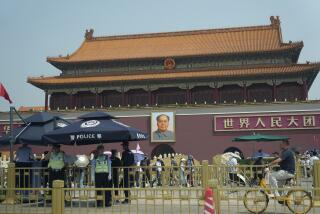In India, Tibetan Refugees Tell Tales of Torture and Chinese Oppression
- Share via
NEW DELHI — The young Tibetan, an actor turned street vendor, was not surprised in the least when he heard about the Chinese army’s bloody crackdown on pro-democracy demonstrators in Beijing in June.
A year earlier, he said, soldiers of that same army broke his right leg, cracked open his forehead with an electric cattle prod and beat him senseless every day for a month after he was caught taking part in pro-independence demonstrations in Tibet, which Chinese troops occupied in 1950.
“You must understand, I consider the Chinese as butchers,” the 29-year-old Tibetan said in an interview Sunday, a few weeks after he arrived in India, a scarred, limping and frightened refugee. “My father and mother were butchered years ago as a result of Chinese repression. So, when I heard the news of Tian An Men Square (the June 3-4 massacre), I wasn’t surprised.
‘Fox Needs Meat’
“The Chinese are like foxes,” he added. “The fox needs meat to keep himself alive. Similarly, the Chinese politician needs to kill to survive.”
The young Tibetan, who asked not to be named because he left his wife and 4-year-old child behind when he fled Lhasa in May, is hardly alone, either in his plight or his perspective.
Instead, he is among scores of increasingly militant, newly arrived Tibetan refugees, and his personal saga of torture and oppression in the Himalayas is a gnawing reminder of China’s other nightmare: the nearly 40-year-old independence struggle of 6 million Tibetans.
In the wake of the June crackdown, leaders of Tibet’s opposition government-in-exile are trying to refocus world attention on Tibet where, they say, recent army repression has been at least as brutal as that in Beijing.
Accused of Exaggerating
“For the last 40 years, we have been trying to convince the outside world of the brutality of the Chinese authorities,” said Tashi Wangdi, one of seven ministers in the government of Tibet’s spiritual leader, the Dalai Lama, and his permanent representative in New Delhi. “But even those who supported our cause felt we were exaggerating a bit.”
Now, he added, “it’s quite clear for all to see. Recent events have exposed the true Chinese character to the outside world, and now people see that we really have been the victim of a ruthless power.”
For their part, Chinese authorities consider advocacy of Tibetan independence to be treason. In addition, they deny that political prisoners in Tibet are tortured.
Still, Tibet remains under martial law, the only Chinese region outside Beijing where the army remains on the street. And it has endured the military presence longer than the Chinese capital.
Tibet has been under martial law for more than five months, ever since police opened fire on a nonviolent demonstration of Buddhist monks, nuns and civilians, such as the 29-year-old former actor.
Such demonstrations have been staged periodically since the Chinese occupation, which in 1959 forced the Dalai Lama and tens of thousands of other Tibetans to flee to the northern Indian city of Dharmsala, where the religious leader set up his government. An estimated 80,000 Tibetans now are in exile.
In recent years, the street rallies have been growing in intensity and numbers. They have attracted an ever-widening spectrum of Tibetan society--men such as the young former actor, who was fired from his Chinese government job and had to turn to hawking secondhand pants and shoes on the streets after he joined several demonstrations.
The Chinese authorities, in turn, have intensified their response, leading to the formal declaration of martial law March 7.
The Venerable Nawang Ring Ma, a 19-year-old lama from Drepung Monastery--which had 7,700 monks before 1959 and now has only 300--said he has witnessed the phenomenon firsthand.
Before fleeing for India a week after martial law was declared, the young monk had been jailed twice, he said--”the first time for three months and 18 days, the second, for five months and 12 days.”
The most brutal incident, Ma said, occurred last year, when he was arrested with 50 other monks who were demonstrating at a Buddhist shrine in Lhasa.
“They handcuffed us, took us to the local police station and hung us from the ceiling by our hands,” he recalled. “Then, they opened all the windows and doors and shouted to the people outside, ‘You see these monks! This is what will happen to you if you demonstrate!’ ”
Enraged at the sight of robed monks dangling in shackles, the crowd attacked the station and set fire to the front door, Ma recalled.
Random Shooting
“The police started shooting at random,” he said. “With my own eyes I saw an elderly Tibetan carrying the dead body of a young child.”
In the coming five months, the monk recalled, he was beaten and shackled daily and was kept in solitary confinement. His wrists still bear the scars of the irons he said were kept on him.
“They kept asking me to sign a document promising never to take part in demonstrations again,” Ma said. “When I insisted on saying no, they hung me from the ceiling by my feet and beat me until I could no longer resist. I signed the paper.”
When they released him, he said, “a senior Chinese police officer told me, ‘If you take part in any future demonstrations, we will burn you in front of your parents.’ I did take part in the March demonstrations, and my parents told me to flee. They said, ‘If you escape now, you might die trying. But, if you stay here, you will certainly die.’ ”
Asked whether the brutality that he described has led him to rethink the Tibetan opposition’s long commitment to nonviolence, the monk said, “Yes, it is very difficult to challenge the Chinese with only nonviolent methods in Tibet. Maybe to take up arms and sacrifice one’s life is needed now.”
Commitment to Nonviolence
Even a few years ago, such words would have been unimaginable from Tibetan exiles. The commitment to nonviolence is the main cornerstone of the teachings of the Dalai Lama. To disobey him is to challenge Tibetan Buddhism’s ultimate religious authority.
“So far, it is the respect for His Holiness’ authority that has kept people from pursuing a more violent approach,” said Tashi Wangdi, referring to the Dalai Lama by his traditional title. “He has said he will abdicate (from) the movement if it turns violent.”
But, he added, “There is a very vast majority of Tibetans--a silent majority, if you will--who feel that whatever negotiations we may have with China, Tibetans will not gain anything out of it. And, even then, negotiations have not yet even begun, and these people are now beginning to say, ‘We told you so.’ ”
Wangdi also noted that Tibetans are closely watching the response of pro-democracy Chinese students, some of whom reportedly have turned to late-night sniper attacks on martial-law troops since the June crackdown.
“The combination of these factors could easily lead to a more violent threat in the Tibetan struggle,” Wangdi said. He added that the frustration is compounded by the fact that Chinese authorities have not responded to the Dalai Lama’s five-point peace proposal made during a June, 1988, speech in Europe.
Still, Wangdi added, there may yet be a bright side to the Beijing bloodbath for the Tibetan people.
“For the new generation of Chinese--especially the students--quite a few of them now realize for the first time how brutal their government can be,” he said. “We think this is very important because, in the long run, we know we have to deal with the Chinese, and these old leaders like Deng Xiaoping (China’s paramount leader) cannot live forever.
“A lot of what has happened in Tibet is because of a lack of knowledge. The Chinese people have built up a mental block. But now we see for the first time the door is slightly open.”
He asserted: “The Chinese people themselves are openly saying, ‘If the army can be so brutal to our own people right here in Beijing, imagine what has been happening in Tibet.’ ”
More to Read
Sign up for Essential California
The most important California stories and recommendations in your inbox every morning.
You may occasionally receive promotional content from the Los Angeles Times.










